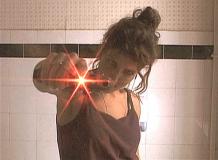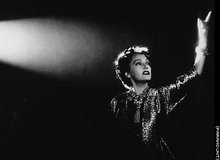


I want to spend our discussion time this week not only on Hamlet and Storytelling, but also other narrative issues we've observed in the films and stories we've looked at thus far. I think this will help focus your thoughts for the final paper. However, at this point I'm not sure I will have the assignment for the final paper fully drafted---so our discussion may be more open ended than I would like. Either way, here are some things to read and think about:
To think more about Storytelling, I suggest you go through all the Student Logs which address this film. Some interesting points have been made in the comment threads---for example, just this morning one of Brittany's logs sparked some new ideas for me that I want to discuss further tomorrow night.
Since we didn't have much time to talk about Almereyda's Hamlet last class, I expect we will spend a lot of time with it. I'm bringing it to class again (also Storytelling) so we can look over some of the scenes and talk about the use of Shakespearian language in the film. The "problems" that students might have with this is soemthing I want to address:not to browbeat you all, but as a jumping off point for questions about language in general. Still, I do have to sneak one criticism in here: you need to read the play first, or at the very least read over the synopsis I provided you with. Although I've asked students to prepare for each of the film's we've screened (and provided much of the material for that preparation), this is one film where such preparation is crucial.
Here are some interesting essays and reviews of Almereyda's film. First, Elvis Mitchell's review in The New York Times, which begins: "It is curious; one never thinks of attaching Hamlet to any special locale," the critic Kenneth Tynan once wrote of Shakespeare's tragedy, and the director Michael Almereyda has brilliantly seized upon that by rooting his voluptuous and rewarding new adaptation of the play in today's Manhattan. The city's contradictions of beauty and squalor give the movie a sense of place -- it makes the best use of the Guggenheim Museum you'll ever see in a film -- and New York becomes a complex character in this vital and sharply intelligent film."
Mitchell highlights one of the things I want to talk more about: the overwhelming presence of New York City in the film. This is integral to the way Almereyda highlights the mediation of the visual image. As Alexandra Marshall points out, "Typical of their generation, Hamlet and Ophelia try to escape into the technologies of image making." And Marshall also links the emphasis on visual technology to the presentation of character in the film: "The characters in this Hamlet are conveyed--with the multiplicity of perspective that also marks our era--as an ensemble of complex personalities with layered and sometimes discomforting histories together."
The dominance of visual media and communication technology is also discussed in Cynthia Fuchs's article on the film: "Poor Hamlet is living in 21st-century Manhattan, where video and electronic surveillance is the norm: cameras find you on sidewalks, stores, offices, elevators. There's no place where you're not on screen, performing consciously or unconsciously for someone's leering and likely profit-minded benefit. "Reality TV" rules: The Real World, Making the Band, Letterman's hijacky street-interviews, Cops, and Big Brother. There are cameras everywhere."
As Fuchs points out, the camera is an instrument of domination, as well as representation---a point also made in Alan A. Stone's review, "...[Hamlet] enters the king’s court, now a corporate press conference, with a video device in each hand; facing down the world with his camera instead of his mordant wit. "
Fuchs also provides a detailed explication of Almereyda's staging of the infamous "to be or not to be" soliloquy in Blockbuster: "He's contemplating his limited options — suicide or homicide? — just as the shot cuts to the store's TV screen, where Eric Draven (Vincent Perez) contemplates one of his own vengeful murders in The Crow Part 2. This reference could not be more astute, not only because the movie features a pissed off dead guy assassinating his own killers, but because this sequel in particular — following Brandon Lee's terrible on-set death in the original Crow — is all about burdens, of history, consumption, and youthful angst, you know, exactly the issues troubling our boy Hamlet."
You can find Almereyda's own thoughts on the film here. A few excerpts: "I was hovering over various possibilities, relatively obscure plays -- and I was resisting Hamlet. It seemed too familiar, too obvious, and it's been filmed at least 43 times. Better to leave it to high school productions, spoofs and skits and The Lion King. As T. S. Eliot noted years back, Hamlet is like the Mona Lisa, something so overexposed you can hardly stand to look at it.
But masterpieces are definably masterpieces because they have a way of manifesting themselves in our everyday lives. The play, and the character, seemed to be chasing me around New York. I passed high school kids quoting Hamlet on the street. I was informed of the existence of a Hamlet porno film. And I found myself thinking back to my first impressions of the play, remembering its adolescence-primed impact and meaning for me -- the rampant parallels between the melancholy Dane and my many doomed and damaged heroes and imaginary friends: James Agee, Holden Caulfield, James Dean, Egon Schiele, Robert Johnson, Vladimir Mayakovsky, Jean Vigo.
...Through all this I was watching every version of Hamlet available in New York, scheduling systematic visits to the Museum of Modern Art, the Museum of Television and Radio and the Library for the Performing Arts at Lincoln Center. (This is a curiously claustrophobic activity. You plug yourself into headphones and a monitor mounted within a tight Formica cubicle, surrounded almost exclusively by middle-aged men studying old Broadway musicals.)"
































No comments:
Post a Comment